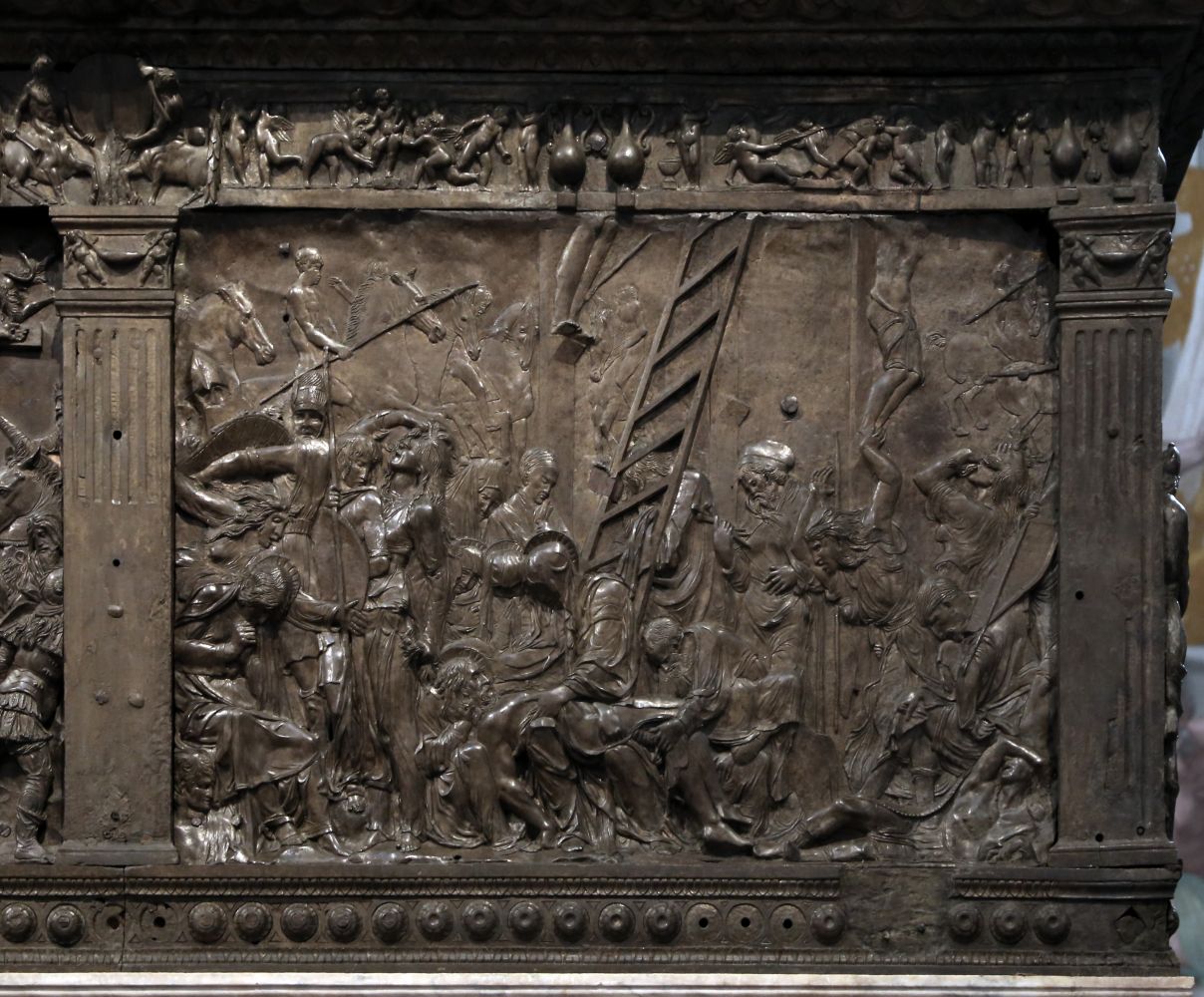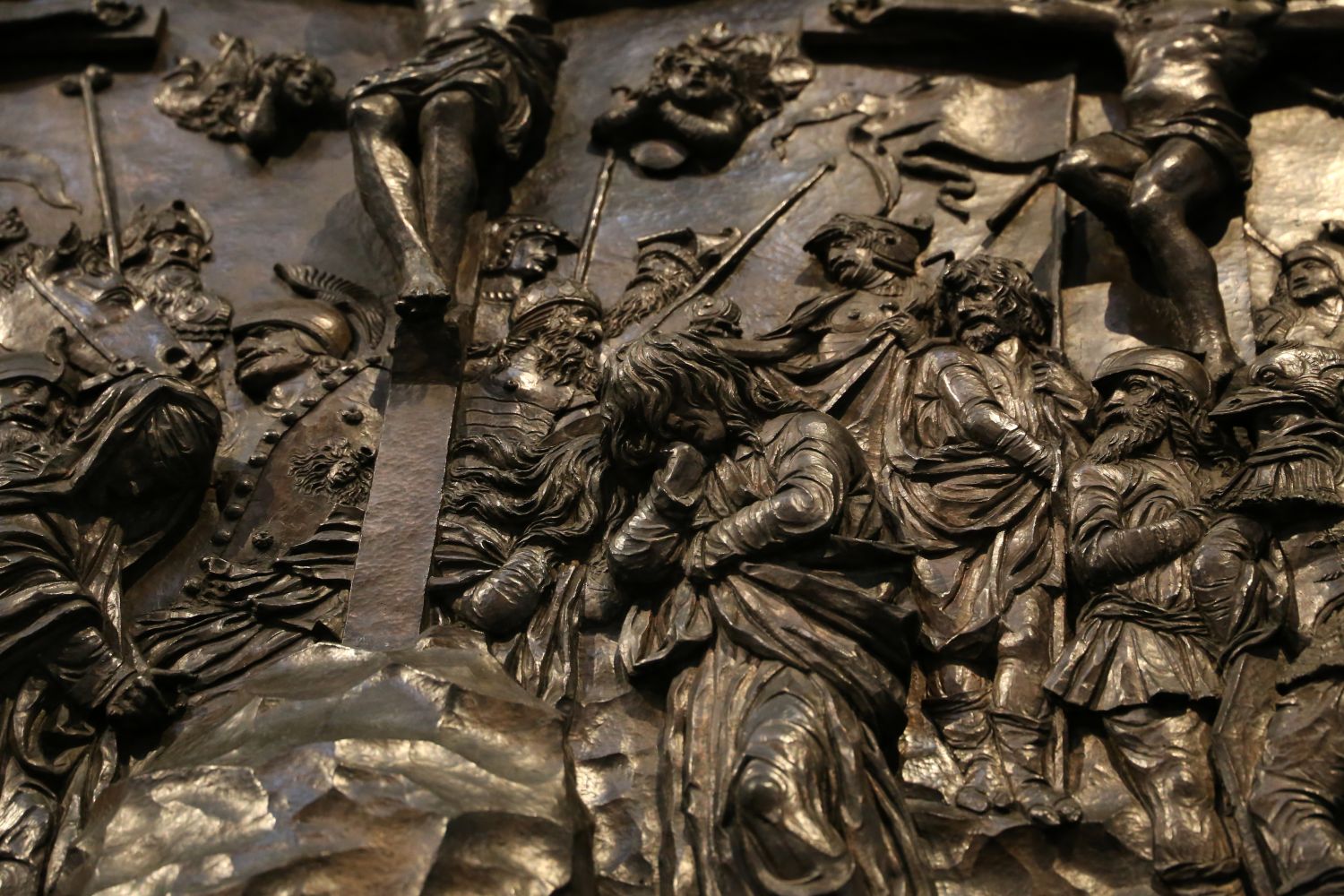

Donatello, who we have already met several times, decided to come back to his homeland, Florence, after a long stay in Padua. He stated that he “didn't want to die among those Paduan frogs”, and instead wanted to breathe his hometown’s air again. Donatello was seventy years old in 1465, had serious sight issues, and, worst of all, had arthritis in both hands; you couldn’t imagine a worse condition for a sculptor, who used to work so vigorously. And incredibly, despite his achievments, towards the end of his life it turned out that he was pennyless: Piero de'Medici had tried to help him by offering him a meager pension. But even during those extremely difficult times, he was hired by Cosimo the Elder to mould the bronze panels of two pulpits in the San Lorenzo Basilica - the Medici family’s parish church, and the oldest in town. This was an ambitious and challenging commission. One pulpit would depict stories of Jesus Christ's Crucifixion, while the other depicted stories of Jesus Christ's Resurrection. The pulpits were probably intended for the two pillars on either side of the tribune - reminiscent of the San Marco Basilica in Venice - with the decorated longer sides facing the nave. In both a religious and a metaphorical sense, they completed the high altar, and Cosimo’s tomb, like an altarpiece. Verrocchio was chosen to produce the latter; while Donatello became the Medici family sculptor over time, Verrocchio was born to the role, and retained it until his death.
In two years, Donatello managed to deliver the job, with a number of highly-skilled collaborators working alongside him; his long-time co-worker and pupil Bertoldo di Giovanni (who would later run the Garden of San Marco) and Bellano from Padua. The technique they used was, of course, the lost-wax process; the panel was first modelled in beeswax, so to be as detailed as possible in the final result, rods of wax were attached to the most convenient positions. Next, both the panel and the attached rods, excluding their tips, were invested, (which simply means covered) with a heat-resistant material such as potter’s clay, which was then left to dry. The whole artefact was heated in a kiln that both fired the clay and burned out the wax (hence the term “lost wax”). The result was a hollow, ceramic mould pierced with the holes —”sprues”— left in the clay by the wax rods. The mould was then filled with molten metal through one of the tubular sprues, while the other sprue released the heated air inside, thus ensuring that the mould was completely filled with metal. After cooling, the clay mould was broken away, revealing the original wax model as well as the sprues, now transformed into metal. The sprues were cut away, and the bronze surface was worked with tools until finished to the desired: this was the hardest thing to accomplish. If you examine the entire piece, focusing on the characters depicted and their draped clothing, hair, and features, you can’t help but notice how skillfully Donatello mastered the use of tempered steel burin to “carve” the bronze like a cake.
Let's focus, for a while, on the panel depicting Jesus Christ praying in Gethsemane, i. e. The Agony in the Garden. In the Catholic tradition, in the Gospel of Matthew, Jesus is in deep anguish. He asks his apostles, Peter, John and James, to pray, meditate and watch alongside him, only to come back to them and find them asleep. Unsettled, he wakes them up and asks Peter: "So, could you not watch with me for one hour?"
No artist has ever (or will ever) depicted the disciples in such a profound, human, or even childlike sleep - the images really remind me of tired babies suddenly falling asleep! They're totally oblivious, unaware about what is going on, or what is going to happen. Now let’s take a look at the Crucifixion, with Jesus Christ flanked by a pair of angels, crying out in such sorrow that their facial features have been deformed in an almost expressionist way; Saint John afoot the Cross, a handsome young man, drowning in his own tears, has his face covered by his long hair. Mary Magdalene's reaction is so hysterical and furious that it reminds us of a Maenad's wrath (Maenads were women following Dionysus, God of wine and religious ecstasy, who were believed to perform frenzied dances and orgiastic rituals when possessed by him, and who were capable of tearing animals or people to pieces during those rituals, such as what happened to Orpheus). Mary Magdalene could be a sort of reference to an ancient Roman sarcophagus depicting maenads, such as the bearded Dacian prisoner held captive by a typical Roman soldier. Let's not forget that, in his youth, Donatello visited Rome with Filippo Brunelleschi, admiring certain cornerstones of Classical art such as the Trajan's Column.
Now let’s take a look at the Descent from the Cross-Lamentation over Dead Christ, which is a display of great skill in working with steel burin (as seen in the other reliefs). Each infinitesimal “layer” of bronze is used to create multiple perspectives. Donatello had proven throughout his life that he was capable of such results, since the invention of the “stiacciato” (“flat relief”) in the predella of the St. George for the Tabernacle of the Guild of the Armourers, now at the Bargello Museum, which depicts St. George fighting a dragon. In the predella, the trees almost seem to be fading into the distance; the clouds scuttling across the sky provoke a sense of endless open space, delineated against the background using the stiacciato technique.
Christ's body is swathed in a tight shroud that enhances his handsome physique, while women flock around him, wailing (like the “plorantes” of late Gothic Burgundian wooden sculpture). Look particularly at the Virgin Mary’s face, while she hugs her son for the last time. The subtle carving here was enough to synthetically define the image.
Speaking of the pulpit of the Resurrection, let's focus on Jesus Christ’s descent into Limbo.
John Pope Hennessy, who wrote about Donatello immediately after World War Two, drew an impressively evocative parallel between this Limbo Christ is descending into, to liberate the Prophets (including Saint John the Baptist, who is welcoming him), the Patriarchs, and the decrepit Progenitors and send them to Heaven, and a concentration camp. The most impressive depiction here, however, is the Resurrection. Normally, we would expect a majestic representation, an event taking place in full daylight, with Jesus Christ rising from the tomb in glory, such as that within the Resurrection by Piero della Francesca. But this is nothing like that. This Redemptor coming away from the grave is scared, weak, like a human being crawling from the underworld; he is not defeating Death like a God. And this is the real essence of Humanism.
Let's then finish this overview by focusing on the Martyrdom of St. Laurence, who was burnt alive on a gridiron like a piece of meat, during Valerian the Emperor's persecution. Look at his body: so realistically consumed by fire, literally melting, and thus similar (according to some art historians) to the mummified bodies in Pompeii. This piece is so different to the Saint Laurence frescoed by Agnolo Bronzino one century later..!
Giovedì 29 aprile 2021
